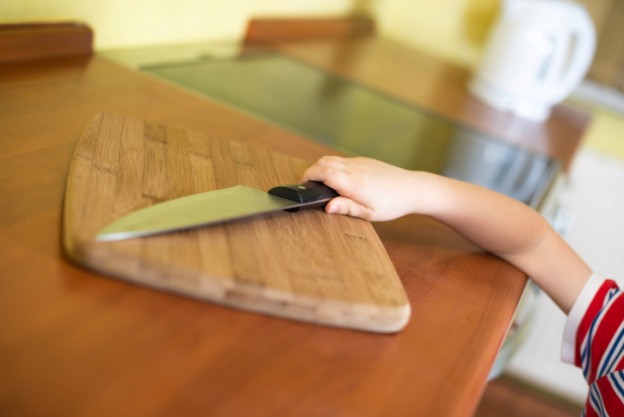
Resources  You never know when your child might start playing with the controls on your gas stove, or attempt cooking on his or her own. It is for this reason that I had a licensed gas fitter install a shut-off valve in the kitchen cupboard right beside my stove. We are always careful to not let Michael see us reaching for it. When it's in the off position, we can rest assured knowing that our gas burners cannot be ignited, nor can toxic gas vapors unknowingly be released into our house.
You never know when your child might start playing with the controls on your gas stove, or attempt cooking on his or her own. It is for this reason that I had a licensed gas fitter install a shut-off valve in the kitchen cupboard right beside my stove. We are always careful to not let Michael see us reaching for it. When it's in the off position, we can rest assured knowing that our gas burners cannot be ignited, nor can toxic gas vapors unknowingly be released into our house.
 While there are many common houseplants that are dangerous if ingested by pets, some are poisonous to humans as well. Find out what they are and make sure that they are not in your home if your child shows any interest in or tendency to eat non-edible items like plants. One helpful resource on toxic plants has been made available online by the New York Botanical Garden.
While there are many common houseplants that are dangerous if ingested by pets, some are poisonous to humans as well. Find out what they are and make sure that they are not in your home if your child shows any interest in or tendency to eat non-edible items like plants. One helpful resource on toxic plants has been made available online by the New York Botanical Garden.
 The convenient electronic locks that are sold in hardware stores for people's exterior doors are perfect for interior uses in homes when you need to prohibit access to certain rooms. We have one at the top of our stairs to the basement and another on the door to our furnace room where we store dangerous tools, chemicals and other potentially hazardous items.
The convenient electronic locks that are sold in hardware stores for people's exterior doors are perfect for interior uses in homes when you need to prohibit access to certain rooms. We have one at the top of our stairs to the basement and another on the door to our furnace room where we store dangerous tools, chemicals and other potentially hazardous items.
 If you are done with your food processor, wash the blade, dry it and put it out of reach before you get called away from the kitchen by the doorbell or move on to some other household task or distraction and forget all about the dangerous object that's been left within your child's reach.
If you are done with your food processor, wash the blade, dry it and put it out of reach before you get called away from the kitchen by the doorbell or move on to some other household task or distraction and forget all about the dangerous object that's been left within your child's reach.
 The water flowing from a hot water tank set on its highest setting can cause severe burns. Be sure that your tank is set nowhere near this temperature, in the event that your child accesses a hot water faucet somewhere in your house and only runs the hot water tap.
The water flowing from a hot water tank set on its highest setting can cause severe burns. Be sure that your tank is set nowhere near this temperature, in the event that your child accesses a hot water faucet somewhere in your house and only runs the hot water tap.
 We took all fireplaces out of our home when we moved in. I love them but they make me too nervous. If you must have one, I'd suggest a gas unit as you can control when it is on and when it is off, unlike a wood-burning fire which you cannot easily extinguish. Having said this, the glass panes in front of gas fireplaces can get extremely hot. If you must have a fireplace of any kind, use with caution. Same-room supervision is an absolute must.
We took all fireplaces out of our home when we moved in. I love them but they make me too nervous. If you must have one, I'd suggest a gas unit as you can control when it is on and when it is off, unlike a wood-burning fire which you cannot easily extinguish. Having said this, the glass panes in front of gas fireplaces can get extremely hot. If you must have a fireplace of any kind, use with caution. Same-room supervision is an absolute must.
 Michael loves nectarines and peaches. However, they have already proven to be dangerous to him as their pits pose a choking hazard for him due to his compromised oral motor abilities. We therefore never keep them in our upstairs fridge until we have removed their pits. When intact, all peaches and nectarines must be stored out of Michael's reach, in our basement refrigerator. If there are any foods that are potential choking dangers or allergy risks for your child, be sure to keep safely away from his or her reach.
Michael loves nectarines and peaches. However, they have already proven to be dangerous to him as their pits pose a choking hazard for him due to his compromised oral motor abilities. We therefore never keep them in our upstairs fridge until we have removed their pits. When intact, all peaches and nectarines must be stored out of Michael's reach, in our basement refrigerator. If there are any foods that are potential choking dangers or allergy risks for your child, be sure to keep safely away from his or her reach.
20 Tips For Keeping Your Child With Special Needs Safe In Your Home
Many individuals with Autism and other special needs, including my 18-year-old son, Michael, might not be aware of the numerous potential dangers that exist in our homes. That is why we, as parents of kids with special needs, often need to be extra vigilant when it comes to household safety, remembering that "child-proofing" our homes is sometimes necessary for our adult offspring as well as our young children. Here are 20 tips that can help you keep your child or someone else with special needs safe while he or she is in your home.1. Hidden gas shut-off valves
 You never know when your child might start playing with the controls on your gas stove, or attempt cooking on his or her own. It is for this reason that I had a licensed gas fitter install a shut-off valve in the kitchen cupboard right beside my stove. We are always careful to not let Michael see us reaching for it. When it's in the off position, we can rest assured knowing that our gas burners cannot be ignited, nor can toxic gas vapors unknowingly be released into our house.
You never know when your child might start playing with the controls on your gas stove, or attempt cooking on his or her own. It is for this reason that I had a licensed gas fitter install a shut-off valve in the kitchen cupboard right beside my stove. We are always careful to not let Michael see us reaching for it. When it's in the off position, we can rest assured knowing that our gas burners cannot be ignited, nor can toxic gas vapors unknowingly be released into our house.
2. Appliances with special safety features
More and more appliances manufacturers are featuring safety features in their products like hidden on and off switch panels and buttons that need to not only be pressed, but held in order to make them operational. When appliance shopping, ask your salesperson about special lock-outs and and other safety features that may exist or research them yourself online. Some brands and models are better than others when it comes to safety.3. Key locks on medicine cabinets
When taken incorrectly, medicine can kill. We have keyed locks on all of our medicine cabinets and the keys are carefully hidden away.4. Toxic houseplants
 While there are many common houseplants that are dangerous if ingested by pets, some are poisonous to humans as well. Find out what they are and make sure that they are not in your home if your child shows any interest in or tendency to eat non-edible items like plants. One helpful resource on toxic plants has been made available online by the New York Botanical Garden.
While there are many common houseplants that are dangerous if ingested by pets, some are poisonous to humans as well. Find out what they are and make sure that they are not in your home if your child shows any interest in or tendency to eat non-edible items like plants. One helpful resource on toxic plants has been made available online by the New York Botanical Garden.
5. Radiator covers
We had Michael's room entirely 'child-proofed' – or so we thought – until one night when I went to check on in him when he was fast asleep and discovered blood trickling down his arm. Beside him was the metal radiator cover whose sharp metal blade had cut him after he decided to take it into bed with him. Now, all metal covers like this have either been screwed down or replaced by less dangerous wooden ones. By the way, if your child discovers that these air vent covers are removable, he may be tempted to remove them and drop things down the vents which can at best, be a nuisance. This might be another reason for you consider the option of screwing these covers down.6. Electrical outlets
Jamming metal objects into electrical outlets can result in severe injury or even death. There are many different devices on the market to prevent this from happening or at least slow down access to these dangerous temptations.7. Knives & other sharp objects
Knife blocks are a no-no in our house. We have a special drawer in our kitchen with a lock installed on it where we keep not only knives, but other sharp or dangerous kitchen tools like peelers, graters and corkscrews.8. Code locks for dangerous rooms
 The convenient electronic locks that are sold in hardware stores for people's exterior doors are perfect for interior uses in homes when you need to prohibit access to certain rooms. We have one at the top of our stairs to the basement and another on the door to our furnace room where we store dangerous tools, chemicals and other potentially hazardous items.
The convenient electronic locks that are sold in hardware stores for people's exterior doors are perfect for interior uses in homes when you need to prohibit access to certain rooms. We have one at the top of our stairs to the basement and another on the door to our furnace room where we store dangerous tools, chemicals and other potentially hazardous items.
9. Get into the habit of putting dangerous items away... right away
 If you are done with your food processor, wash the blade, dry it and put it out of reach before you get called away from the kitchen by the doorbell or move on to some other household task or distraction and forget all about the dangerous object that's been left within your child's reach.
If you are done with your food processor, wash the blade, dry it and put it out of reach before you get called away from the kitchen by the doorbell or move on to some other household task or distraction and forget all about the dangerous object that's been left within your child's reach.



